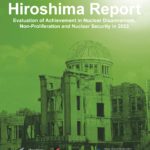(9) Transparency in Nuclear Forces, Fissile Material for Nuclear Weapons, and Nuclear Strategy/Doctrine
In the Final Document of the 2010 NPT RevCon, the NWS were called upon to report on actions taken toward “accelera-t[ ion of] concrete progress on the steps leading to nuclear disarmament” to the 2014 NPT PrepCom (Action 5). All states parties to the NPT, including the NWS, were also requested to submit regular reports on implementing nuclear disarmament measures agreed at the previous NPT RevCon (Action 20), and the NWS were asked to agree on a standard reporting form as a confidence-building measure (Action 21).
In accordance with these recommendations, the NWS submitted their respective reports on implementation of the NPT’s three pillars (nuclear disarmament, non-proliferation and peaceful use of nuclear energy) to the 2014 NPT PrepCom and the 2015 RevCon, using a common framework, themes and categories. While no similar report was submitted by any NWS to the 2017 and 2018 NPT PrepComs, China212 and the United Kingdom213 submitted their respective reports to the 2019 PrepCom. As for NNWS, only seven countries (Australia, Austria, Canada, Italy, Japan, the Netherlands and New Zealand) submitted their respective implementation reports on the NPT.214
In 2020, there was no particular progress made with regard to transparency in nuclear forces, fissile material for nuclear weapons, and nuclear strategy and doctrine, except, as mentioned above, the French and Russian introduction of their respective nuclear policies.
Among nuclear-armed states, the United States has in the past been considered the most transparent with regard to nuclear issues. However, in recent years, especially under the Trump administration, the amount of information released from the United States has seen a decline. As mentioned above, the Department of Defense decided not to disclose information regarding the current number of possessed and dismantled nuclear weapons, as requested by a U.S. think tank. In addition, the status of nuclear weapons-related tests that did not detonate has not been updated since the first quarter of 2015, and no past information has been available since 2018.
China, in the meantime, rebutted the U.S. criticism of China’s lack of transparency, stating that its nuclear strategy and intention are more transparent and predictable, citing China’s pledge of no-first-use of nuclear weapons as well as security assurances for NNWS.215
At the 2012 NPT PrepCom, the NPDI proposed a draft form for reporting on nuclear warheads, delivery vehicles, fissile material for nuclear weapons, and nuclear strategy/policies.216 Using the draft form, the following table summarizes the degree of transparency taken by the nuclear-weapon/armed states.

212 NPT/CONF.2020/PC.III/8, April 29, 2019.
213 NPT/CONF.2020/PC.III/7, April 25, 2019.
214 Among these countries, Australia, Austria, Canada, Japan and New Zealand also submitted their respective report to the 2018 NPT PrepCom.
215 Gu Liping, “Fu Cong: China Has Transparent and Defensive Strategy, It’s Not a Nuclear Threat,” CGTN, October 16, 2020, http://www.ecns.cn/news/politics/2020-10-16/detail-ihaazqys6709048.shtml.
216 NPT/CONF.2015/PC.I/WP.12, April 20, 2012.






